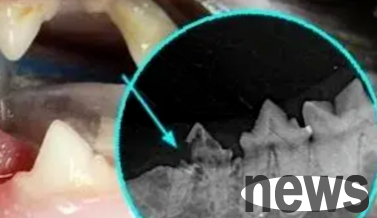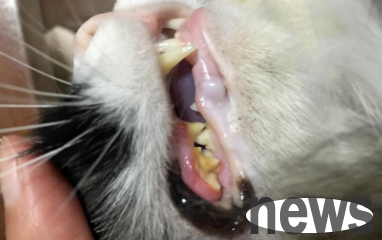Cat periodontitis is an acute or chronic inflammation of the periodontal membrane and its pervasive tissue, with a long and secret course. It begins with gingivitis, which then develops into periodontitis, the number one killer of oral health in humans and animals. It is an inflammation involving periodontal ligaments and alveolar bone, which ultimately leads to loss of attachment (periodontal pockets, gingival atrophy, bone resorption). It rarely occurs in a single tooth, and is often generalized. A survey shows that the incidence of periodontal disease in cats over 5 years old is more than 70%.
1. The initial stage of periodontitis is called gingivitis, which is an inflammatory reaction to the gingival tissue. It often initially shows related symptoms such as redness and swelling on the edge of the gingival gums, and ulcers may occur later. The gums are very fragile at this time and spontaneous bleeding may occur. Plaque is the culprit for gum disease. Plaque is a microbiome that adheres to the surface of a tooth or other soft tissue in the oral cavity. It consists of a large number of bacteria, intercellular substances, a small amount of white blood cells, shed epithelial cells and food residues. When salivary glycoprotein in the oral cavity comes into contact with the teeth, it can adhere to the enamel surface, forming a membrane-like substance (called acquired membrane), which provides a matrix for the initial adhesion of oral bacteria and creates conditions for the formation of plaque. Bacteria grow on the surface of the acquired membrane and can produce acids, which can deposit glycoproteins and synthesize dextran. Together with deposited glycoproteins, forming the plaque matrix creates the basis for the formation of plaque.
After the bacteria that reproduce in large quantities on plaque produce toxins and enzymes, it first causes inflammation of the gums. At the same time, the bacteria increase the pH of the saliva and become alkaline, causing the protein in the saliva to decompose and release calcium salts, which hardens and becomes tartar. Tartars are prone to attachment to tartars. The hole between the teeth and gums is getting deeper and deeper, and the gums are swollen and bleeding. Not only the gums, but also the damage to periodontal tissues such as the root membrane, cementum, and alveolar bones that support the teeth are also more common. Gradually, the alveolar bones are absorbed, the force supporting the teeth weakens, and the teeth become loose. This is called periodontal disease.

Summary of the cause
01 The attachment of tartars produces mechanical stimulation induces.
02 After the teeth fall out, food residues accumulate at the roots of the teeth, causing infection.
03 Improper feeding management, food lacks trace elements and vitamins.
04 Certain infectious diseases and chronic systemic diseases, such as calicivirus, diabetes, nephropathy, hyperthyroidism and hereditary diseases.
2. Clinical symptoms
Daily manifestations are bad breath (rotten smell) and salivation; they have appetite but can only eat soft food or liquid food, dare not chew food, and occasionally touch and cause severe pain in the teeth. Red gums; loose teeth; falling teeth; eating very slowly and difficult, and appetite decreases. When the above symptoms occur at the same time, you may be infected.

3, diagnosing symptoms, medical history and complaints can provide very useful information. First, oral examinations, and oral examinations in a conscious state, followed by oral visual examinations, probe detection and dental X-ray examinations under anesthesia.
Severe grade:
Level 1: No stones on the teeth, occasionally plaque bacteria are attached, mild redness of the gums, X-ray examination shows good health and reversible condition of teeth and gums.
Level 2: There is plaque attached to the teeth, there are few tartars, the gums are slightly swollen with flushing, X-ray examination shows that the tissue density at the root of the teeth is reduced, and the root of the teeth is slightly loose.
Level 3: Dental stones are seen in the naked eye, gingival atrophy or hyperplasia, accompanied by redness, swelling, bleeding, bad breath, X-ray examination further expands the reduction range of tissue density at the root of the teeth, and the teeth are significantly loose.
4: A large number of tartars, gum recession, severe gingival bleeding, accompanied by mouth odor and salivation, X-ray examination shows that the density of the gingival tissue is greatly reduced, many teeth are loose, and serious systemic complications occur.

4, Treatment
(1) to remove the cause. Clean teeth under general anesthesia and remove tartar and tartar completely. If an abscess is found, the pus should be squeezed out and the abscess cavity should be rinsed. For severely loose teeth, it should be removed and combined with drug anti-infection treatment.
(2) Oral disinfection. You can choose to use a sanitary solution with less irritation for oral disinfection, and use a sprayer to spray the affected area of the oral cavity, more than 4 times a day. And spray the medicine solution with wound repair effect
(3) for care. Give liquid foods, such as milk, porridge, etc., and rinse the mouth with a syringe after consumption.

5. Prevention
First, regular oral examinations should be performed on the cat, abnormalities should be found, and treatment should be carried out in time. Secondly, remove tartar, tartar, etc. in time to reduce the further aggravation of periodontal disease, use oral care solution for oral care, and reduce the growth of bacteria on plaque. You can also frequently bite the cats into toys such as glue to exercise your teeth and remove tartar. There are also professional teeth-specific cat foods on the market that can help reduce the growth of plaque.